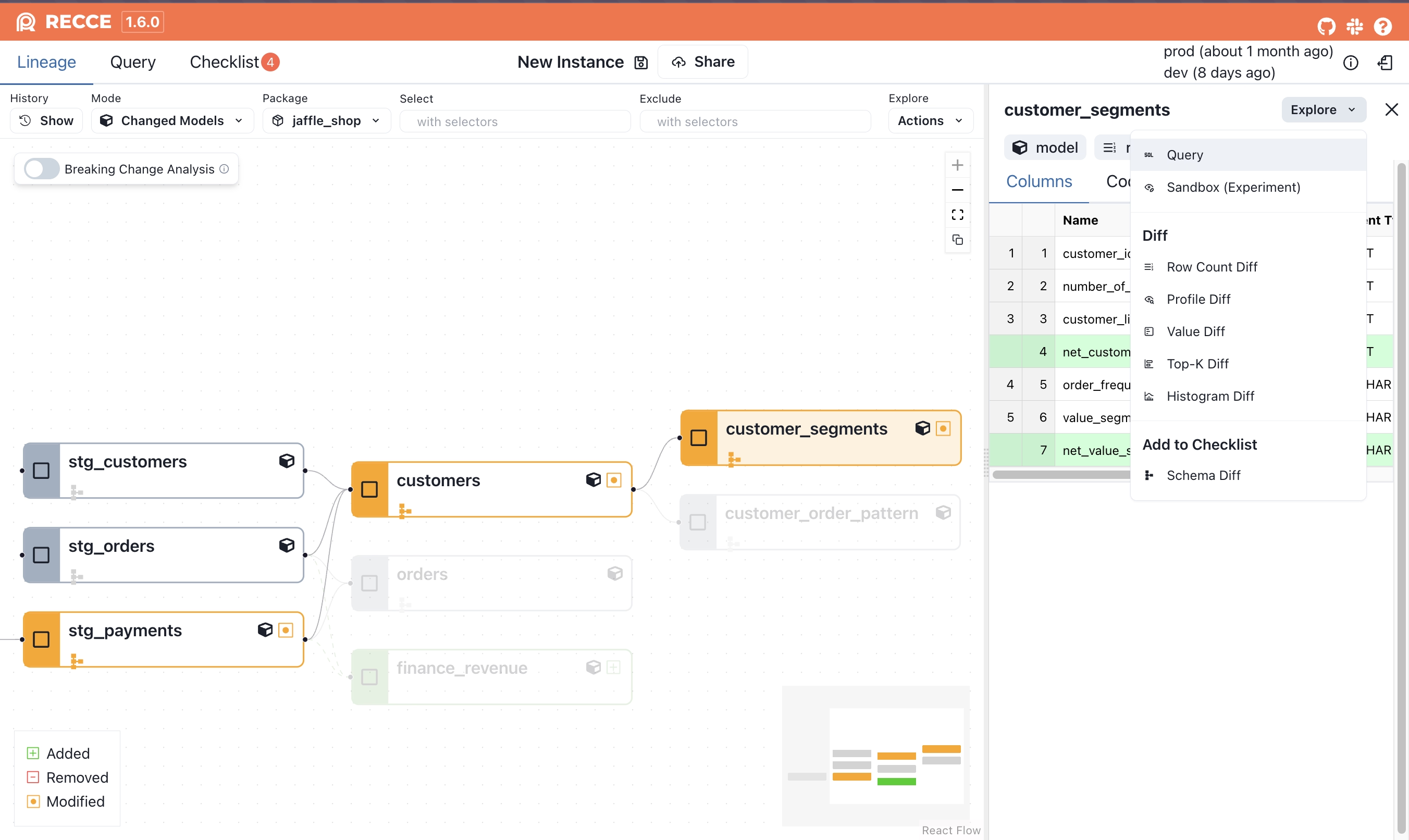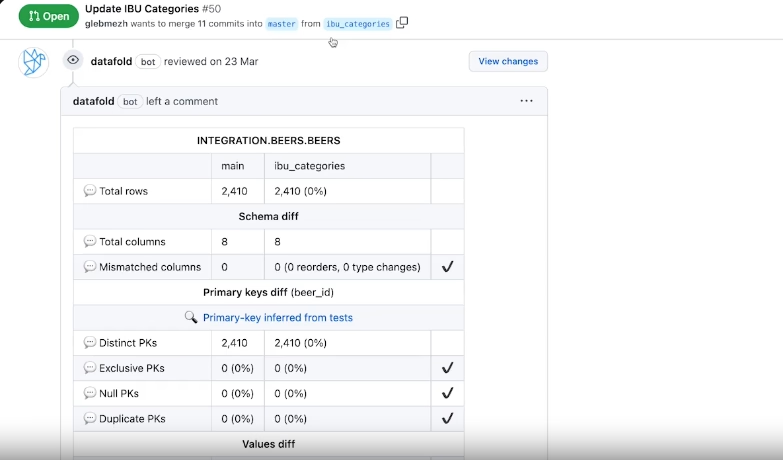Recce vs Datafold: Validate What Matters or Automate Everything?
Many teams come to Recce after evaluating Datafold. Some tried it in production, others ran a PoC (Proof of Concept). But for many teams, it doesn’t quite match how they want to review and validate changes.
The value didn't justify the effort. The setup friction, combined with noisy results, partly due to our staging model patterns, made it hard to trust or adopt. And today, the discontinuation of the open-core repository makes it even less likely we'd consider it again, as we typically prioritize tools that let us start small and grow adoption organically.
TL;DR
- Recce is open-source-first and optimized for interactive data validation. Start with data lineage, explore what’s impacted, run diffs where it matters and then automate the process. Helps teams turn ad-hoc validation into repeatable, collaborative workflows.
- Datafold offers deep CI/CD integration and production monitoring, but can feel heavy, noisy, and costly for development workflows. Helps team with large datasets and complex data migrations.
Both tools require maintaining dual environments (e.g., development and production) to compare results.
Comparison overview
Here’s a side-by-side comparison of key features and capabilities for a quick glance:
| Capability | Recce | Datafold |
|---|---|---|
| Data diff | ✅ Diffing between two dbt environments (schemas); supports schema, value, profile, top-K, histogram, row count, and query diffs | ✅ Data Diff within and across databases; schema, value, profile, and row count diffs; optimized for large-scale, in-database and cross-database comparisons |
| Support | ⚠️ dbt-focused (requires dbt project); others are planning | ✅ Support any orchestration and transformation tool |
| Exploration | ✅ Impact exploration by diffing two dbt environments; Lineage diff, breaking change analysis, impact mapping, column-level lineage | ✅ Data Explorer for a single environment; column-level lineage across dbt, BI, and data apps |
| Collaboration | ✅ Checklist for reviews, shareable standards, PR gating, real-time sync to Recce Cloud | ⚠️ PR comments with diff results in CI/CD |
| Automation approach | ✅ Human-in-the-loop. You define what to check, when to diff, and what to automate. | ✅ Fully automated. Diffs run on all changed models by default, regardless of relevance. |
| Monitoring | ❌ Not supported | ✅ Data Monitors for production anomaly detection (volume, schema drift, etc.) |
| Migration | ❌ Not supported | ✅ Data Migration Automation for warehouse migrations and cross-database consistency |
| Setup | ✅ Local-first. No Git or CI required to start. Start locally in minutes with dbt-core; value increases with Cloud and CI/CD integration | ⚠️ Automation-first. While local runs are possible, the core value comes after setting up CI/CD, Git integration. |
| Security | ✅ SOC 2 compliant, runs locally or in private environment, data stays in warehouse | ✅ SOC 2, HIPAA, GDPR compliant, SaaS and single-tenant options |
| Pricing | ✅ Open source as well as free and paid cloud plans publicly listed | ⚠️ Commercial SaaS only contact sales for pricing |
| First release | Nov 28, 2023 | Jun 20, 2022 |
Feature to feature comparison
Let’s dive in key features and how each product handles them
Data diff: targeted exploration vs default automation
In Recce, data diffing is one of several tools used during impact review, not the default starting point. You begin with lineage and metadata, identify what matters, and then drill into diffs where it makes sense.
Recce supports:
- Lineage Diff: to scope the blast radius of changes.
- Breaking Change Analysis: to identify models that require downstream validation.
- Column-Level Lineage: to trace data dependencies precisely.
You can then apply targeted diffing: profile, value-level, Top-K, histogram, row count or custom queries.

By contrast, Datafold treats diffing as a primary mechanism for CI/CD and monitoring, but lacks support for incremental exploration and contextual validation. It compares any two tables, across or within environments, and pushes results into automated pipelines for regression checks and test coverage.
It’s effective for catching issues early, especially in production or large-scale migrations, but this approach is less interactive. Diffs are run blindly across all modified models, often surfacing noise. There’s limited control over what gets diffed and why, which can lead to alert fatigue and inflated compute costs.
Automation: human-in-the-loop vs fully automated
Recce puts humans in control. You explore first, scoping impact through lineage, metadata, and context, then decide what to validate. From there, you choose which validated checks are worth automating. CI is opt-in and scoped to what matters, keeping reviews focused and reducing alert fatigue.
Datafold takes the opposite approach: it auto-diffs all changed models on every PR by default. This provides full coverage and fits well with strict CI/CD pipelines. However, it can generate noise, increase compute costs, and surface low-signal alerts. Slim Diff reduces volume by limiting diffs to changed models, but selection is still at the model level, not logic, or business relevance. There’s no built-in way to prioritize or explain why a change matters.
Pricing: open source first vs fully commercial
Datafold has shifted to a fully commercial model. It’s original open-source data-diff has been sunset, and all core features, CI integration, UI, monitoring, are now behind a sales process. Pricing is not public.
Recce borns as open source and recently introduce Cloud plan. You can start locally with the CLI, use the free Cloud plan to share results, and upgrade to a paid tier for team collaboration. No gatekeeping behind a demo. Pricing is public.
How to choose
Choose Recce if:
- you want control over what to validate, when, and why.
- you value lightweight setup and open-source flexibility.
- you’re focused on development-time validation and team collaboration.
Choose Datafold if:
- you need automated, full-model diffing across CI pipelines.
- you’re running large-scale migrations or monitoring data in production.
- price is not object for your data tooling budget.
Try Recce now
Data diffing is an output, not an outcome. It should be used as a means to support confident and contextual data change review, which Recce shines.
 (
(
